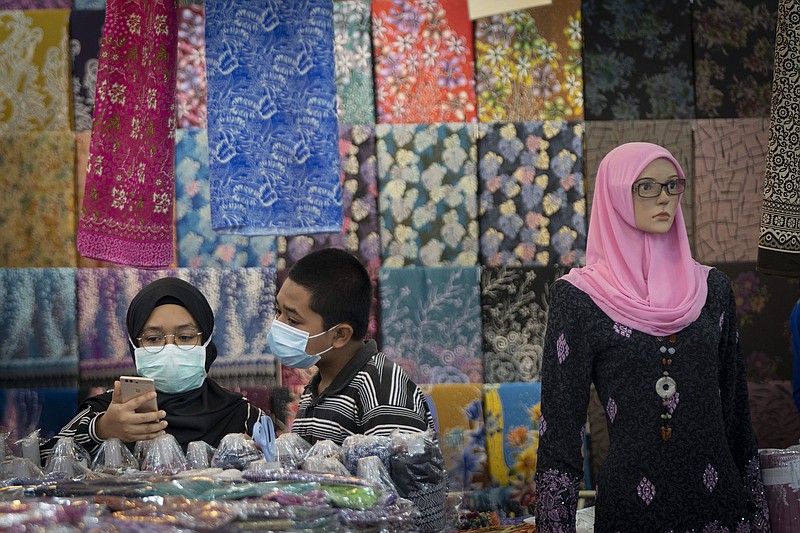Economies in the Asia-Pacific region are forecast to hit the doldrums this year as decades-high inflation and the war in Ukraine compound geopolitical uncertainties and the aftereffects of the pandemic.
A report on Pacific Rim economies by the Asia Pacific Economic Cooperation forum said Friday that growth in the region will likely fall by more than half this year to 2.5% from 5.9% last year, when many countries were recovering from the worst of their covid-19 outbreaks.
In neighboring India, meanwhile, the central bank on Friday increased its key interest rate by half a point to 5.4%, the third increase since May, and the rupee has now plunged to an all-time low.
Weaker growth in the U.S. and China remain a big factor behind the regional malaise, though other economies are also slowing. Russia's economy is expected to contract due to the implications of its war in Ukraine, and the three economies account for nearly 70% of the APEC region's gross domestic product, according to the Pacific Rim report.
It forecast that regional growth would only pick up slightly in 2023, to 2.6%.
Most economies in the region are just beginning to fully emerge from border closures and other pandemic-related precautions. Tourists have reappeared on the streets of Bangkok, but many businesses remain shuttered, casualties of the many months when travel was virtually paralyzed.
In China, where authorities are still imposing lockdowns to wipe out covid-19 outbreaks, the economy contracted 2.6% in the three months ending in June compared with the previous quarter after Shanghai and other cities were shut down to fight coronavirus outbreaks.
The U.S. economy contracted by 0.9% in April-June, while Russia's economy shrank 0.5% in January-June compared with a year before, according to its Ministry of Economic Development.
Japan's economy shrank at a 0.5% annual rate in January-March and is forecast to expand only 2% in the fiscal year ending in March 2023. Some economies are doing better.
Indonesia reported Friday that its economy grew at a better-than-expected 5.4% annual rate in the April-June quarter as it bounced back from a wave of omicron-variant coronavirus infections.
An exporter of raw materials such as coal and palm oil, the country saw its exports jump nearly 20% in the last quarter as prices for many materials soared. But that windfall is likely to dissipate as price increases ease or reverse, analysts said.
"We expect slowing growth in the rest of the world to take its toll ... as commodity prices continue to recede. On the domestic front, headwinds from high inflation, which reached a seven-year high and is set to rise further in the coming months, are growing," Alex Holmes of Oxford Economics said in a commentary.
India is also growing faster than much of the rest of the region, but faces its own troubles.
Reserve Bank of India Governor Shaktikanta Das projected that growth would remain robust, at 7.2% in the financial year ending in March 2023.
But to counter inflation that hit 6.7% in June, the central bank raised its key interest rate on Friday by a half percentage point.
The committee decided "to remain focused on the withdrawal of accommodation to ensure that inflation remains within the target going forward while supporting growth," he said.
Das said the global economic and financial environment has deteriorated with the combined impact of monetary policy tightening across the world and the war in Ukraine raising risks of a recession.
The Indian rupee has plunged to an all-time low of 79.05 rupees to one U.S. dollar. Das attributed its weakness to a strengthening dollar as interest rates rise in the United States.
Multiple waves of covid-19 outbreaks have badly hit India's large informal sector and contact-intensive services like restaurants, hotels, retailing and tourism.
Unemployment has risen to nearly 8%, according to data from the think tank Center for Monitoring Indian Economy.
More than half of the 21 APEC members have raised rates or otherwise tightened monetary policy to counter inflation, which now averages 5.4% for the region, the APEC report said.
It pointed to a 23% overall increase in the food price index of the U.N. Food and Agricultural Organization, noting that inflation is likely to remain elevated for at least the rest of the year as central banks adjust their policies to try to bring it under control.
Information for this article was contributed by Elaine Kurtenbach and Ashok Sharma of The Associated Press.
 FILE - Shoppers wait in line to go in to an outlets at a shopping mall in Putrajaya, Malaysia, Saturday, Oct. 9, 2021. Economies in the Asia-Pacific are forecast to slow sharply this year as decades-high inflation and the war in Ukraine compound geopolitical uncertainties and the aftereffects of the pandemic. (AP Photo/Vincent Thian, File)
FILE - Shoppers wait in line to go in to an outlets at a shopping mall in Putrajaya, Malaysia, Saturday, Oct. 9, 2021. Economies in the Asia-Pacific are forecast to slow sharply this year as decades-high inflation and the war in Ukraine compound geopolitical uncertainties and the aftereffects of the pandemic. (AP Photo/Vincent Thian, File) FILE - Workers carry a building material at the construction of Jakarta International Stadium in Jakarta, Indonesia, Tuesday, Oct. 26, 2021. Economies in the Asia-Pacific are forecast to slow sharply this year as decades-high inflation and the war in Ukraine compound geopolitical uncertainties and the aftereffects of the pandemic. (AP Photo/Dita Alangkara, File)
FILE - Workers carry a building material at the construction of Jakarta International Stadium in Jakarta, Indonesia, Tuesday, Oct. 26, 2021. Economies in the Asia-Pacific are forecast to slow sharply this year as decades-high inflation and the war in Ukraine compound geopolitical uncertainties and the aftereffects of the pandemic. (AP Photo/Dita Alangkara, File)
